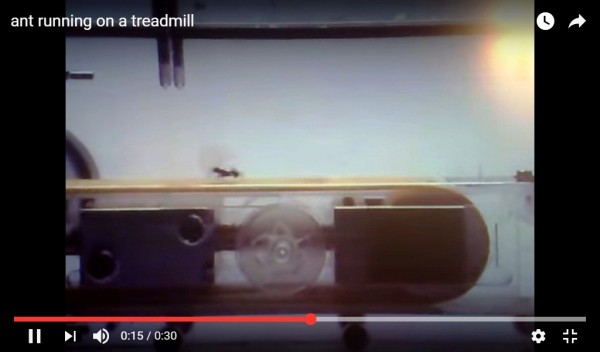By Jenia Cane, | February 17, 2017

Ant Treadmills
German scientists have found a way to study the impressive navigational skills of ants: put them on treadmills. By using the device - a simple spherical treadmill made from Styrofoam - the researchers have gained insight on how ants are able to return home after lengthy walks to gather food.
Like Us on Facebook
The subject of the study were Cataglyphis dessert ants who live in the Saharan salt plains. These crawlers are an incredibly tough bunch, as they able to navigate across a flat, bare hostile environment, and come back by taking the most direct route.
By putting the ants on treadmills, the University of Freiburg, led by Dr. Matthias Wittlinger, wanted to learn the secret behind their extra-ordinary navigational abilities and use the information to build more efficient robots. With the ants placed on top of a Styrofoam ball that is suspended from a blowing air stream, Wittlnger and his team were able to simulate a dessert's actual surroundings, reported Gizmodo.
Despite the ant being tethered to the contraption, the scientists observed that it is still able to walk using its natural gait and easily change directions when necessary. Equipped with optical sensors, the researchers were able to accurately measure the walking speed and angular orientation of the subjects.
Before the ants were put treadmills, the subjects were allowed to leave their nests to search for food in their field and lab settings. On the average, Cataglyphis ants travel a distance of 32 feet while storing crucial information of their journey along the way.
"This gives us almost unlimited possibilities to test the mechanisms and neural basis of our model animal's spatial orientation and navigation-in the laboratory," explained Dr. Wittlinger. "We can place the ants in a virtual world and incorporate certain changes into it to see how they react," he added.
As reported by Popular Mechanics, the ants that were put on treadmills feel completely at home, and don't seem to realize the difference between the device and normal terrain. During the study, the researchers found out that ants have a tendency to conserve energy, move quickly on the initial homeward trip, and then slow down when they reach their nesting area.
The study also found out that when the subjects wanted to find out a specific location, they slowed down. But when the ants on treadmills where travelling in a general direction, they tried to cover as much ground as possible.
-
Use of Coronavirus Pandemic Drones Raises Privacy Concerns: Drones Spread Fear, Local Officials Say

-
Coronavirus Hampers The Delivery Of Lockheed Martin F-35 Stealth Fighters For 2020

-
Instagram Speeds Up Plans to Add Account Memorialization Feature Due to COVID-19 Deaths

-
NASA: Perseverance Plans to Bring 'Mars Rock' to Earth in 2031

-
600 Dead And 3,000 In The Hospital as Iranians Believed Drinking High-Concentrations of Alcohol Can Cure The Coronavirus

-
600 Dead And 3,000 In The Hospital as Iranians Believed Drinking High-Concentrations of Alcohol Can Cure The Coronavirus

-
COVID-19: Doctors, Nurses Use Virtual Reality to Learn New Skills in Treating Coronavirus Patients









